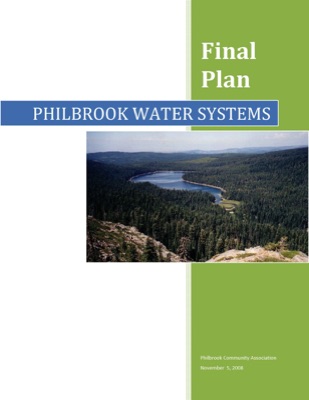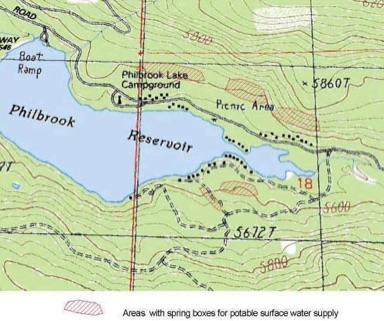Water Resources


Water resources in the Philbrook Valley are a key resource. The lake is a significant attraction for recreation and fishing, and reliable (safe) supplies of potable water are required for all current uses. Philbrook Lake has a storage capacity of 5,370 acre-feet (at full-capacity) with a watershed drainage area of 5 square miles. The flow from the reservoir is completely regulated by PG&E operations. Typical discharge rates vary from 2.5 to 35 cfs with the highest flows in snowmelt and during drawdown in mid- late summer. In recent years, operations have been focused on supply of cold water for temperature regulation in Butte Creek to enhance the downstream salmonid habitat.
Supply of potable water has been developed on an ad-hoc basis over the last 75 years. Many residents use spring boxes and a few use wells. The ownership of adjacent lands has transferred from Diamond Match (now known as Sierra Pacific Industries) to the USFS. As part of the FERC relicensing associated with PG&E operations, the USFS required all residents to develop alternate water source plans if the spring was on public lands. PCA played a key role in identifying requirements and options to meet this new mandate from the USFS. The collection of new and revised water systems plans for all residents is the new Coordinated Water Systems Plan (CWSP) for the area. PCA submitted the CWSP plan to the USFS and it was approved based on their rescission of the associated conditions in the FERC relicensing for the DeSabla-Centerville Hydroelectric Project (FERC Project No. 803-087).
PCA members have a vital interest in protecting the water resources of the valley; much of the recreation is focused on the lake and potable supply is a basic necessity. Primary stewardship activities conducted by PCA to maintain this resource have included discouraging actions which cause erosion into the lake (e.g., illegal OHV use), development of the area Coordinated Water Systems Plan (CWSP), encouraging protection of specific drainage areas used for potable springs/surface water supply, and developing guidelines for reasonable chlorination rates/detention times (within storage tanks) for disinfection.

